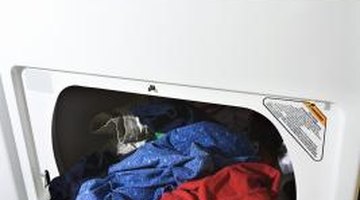How to Test the Continuity of a Dryer Timer
The timer is one of the hardest-working components in a clothes dryer. It is subjected to high electric current surges every time the motor starts up. Those very high surges can cause the timer contacts to burn and weld themselves together in the "closed" position, or cause them to stick in the "open" position. Welding themselves in the closed position causes the dryer to run continuously, even with the timer in the "off" position. Stuck in the open position causes the dryer to not run.

Step 1
Pull the clothes dryer out from the wall and unplug the power cord from the dryer's wall outlet.
Step 2
Locate the electrical wiring diagram, which has a drawing showing which of the timer contacts are closed or open in each cycle position. This diagram may be located on the back of the dryer, on the inside of the dryer cabinet, or as a loose diagram inside the control panel.
Step 3
Remove the screws holding the face of the control panel in place, and unplug the wiring harness from the timer. Set the function switch on the digital multimeter to the R X 1 scale, or to the “continuity” setting if it has one.
Step 4
Study the timer contact diagram to determine which contacts should be in the open position, and which should be in the closed position with the timer in the "off" position. Place the meter test probes on the appropriate numbered terminal. An open set of contacts is indicated by an “O.L.” displayed on the meter's LCD. A closed set of contacts is indicated by “0.000” on the LCD. If the contacts are open when they should be closed or closed when they should be open, replace the timer. If you are using a meter that has a “continuity” test position on the function selection dial, closed contacts are indicated by a buzzing sound, and open contacts results in a no buzzing sound coming from the meter.
Step 5
Place the timer in each of its other cycle positions and repeat the test, checking to see if the contacts that are supposed to be closed are closed, and those that are suppose to be open are open.
Step 6
Check the timer motor contact by turning the timer to the "off" position. With the timer in the "off" position, those contacts should be open. With the timer set to any position other than "off," the timer motor contacts should be closed.
Step 7
Remove the defective timer and take it with you to the appliance parts dealer to get an exact replacement. Take the make, model and serial number of the dryer with you as well, so the parts salesperson can cross-reference the dryer timer if needed to substitute a generic timer motor.
References
Tips
- Use caution when pulling the dryer away from the wall so you don't rip the flexible exhaust tubing.
- Generic brands or universal timers often are considerably cheaper than the brand name part and does the job equally well.
Warnings
- Do not attempt to disassemble and repair a defective timer. A professional might do that in an emergency, but timers contain a myriad of small parts, and reassembling them in the correct manner is well beyond most DIYers.
Writer Bio
Based in Colorado Springs, Colo., Jerry Walch has been writing articles for the DIY market since 1974. His work has appeared in “Family Handyman” magazine, “Popular Science,” "Popular Mechanics," “Handy” and other publications. Walch spent 40 years working in the electrical trades and holds an Associate of Applied Science in applied electrical engineering technology from Alvin Junior College.
Photo Credits
- Jupiterimages/Comstock/Getty Images
More Articles



